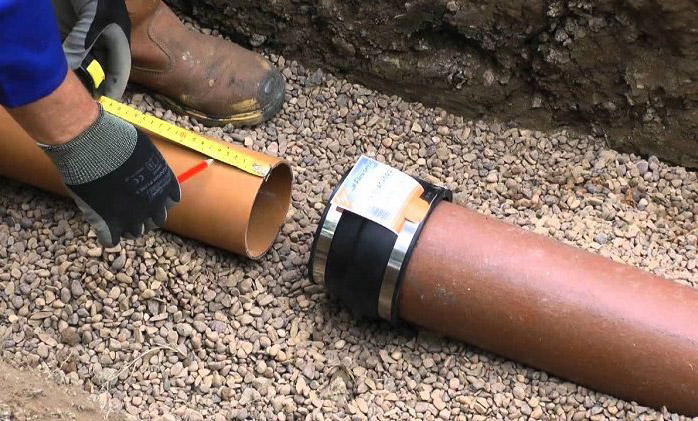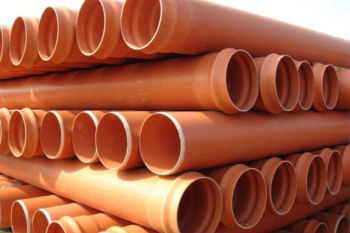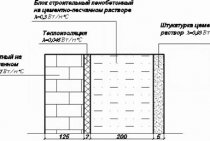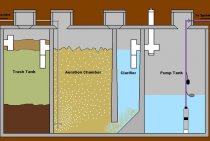Mounting Features
Since ceramic pipes are operated without forced circulation, the flow moves under the influence of gravity. To ensure the normal operation of the sewer network, a mandatory slope is designed, laying communications on a gravel pillow or cement substrate.
Installation is carried out according to the project, connecting individual pipes or segments up to 8 meters in length. Lay communications from the bottom up, with a bell to the direction of flow
Particular attention is paid to sealing joints. For straight products, coupling units are used.
For bell-shaped - it is obligatory to seal the cavity with bituminous, clay, asbestos-cement, cement mortars, asphalt mastic.
The mounting technology is as follows:
- the straight end is wrapped with impregnated tow, inserted into the socket;
- the winding is compacted manually, without impact;
- the cavity is filled with sealing material.
For non-aggressive drains, it is convenient to use bituminous, asphalt mastics on tow. For pipes laid on a concrete base, cement is usually used. Clay can be used to seal sockets, where there is no danger of germination of tree roots.
Physical Properties
Ceramics has many advantages, which makes products made from this material attractive for arranging sewers.
wear resistance
Ceramics outperform metal fabrications in terms of their ability to resist wear.
tightness
Processing clay with high temperatures leads to its sintering. As a result, the finished product becomes quite tight. This is due to certain characteristics of the raw material, which, under the influence of a temperature of 1100-1150 ° C, reduces its porosity to the minimum values.
https://youtube.com/watch?v=PbJBfaUNd-g
Strength
Most of the external pipelines are laid in the ground, which causes the presence of increased mechanical loads. Typically, such effects are smoothed out by optimal design and installation, taking into account the indicated nuance. This approach is reasonable, but it cannot completely eliminate the problem if the material used to make the pipes is relatively brittle.
Ceramic sewer structures exclude the possibility of damage due to the mechanical impact exerted by the soil. The hardness of the material used and its resistance to loads of this kind allow us to hope that over time pipes made of ceramics will not crack, and will not undergo fracture and ovalization.
Waterproof
The tightness of ceramics has been proven, which confirms its water tightness. Therefore, ceramic products, including junctions, reliably hold liquid inside an engineering structure made of pipes. The ability of the joints to keep water out is provided by polyurethane seals, which are elastic couplings, the installation of which is carried out in an industrial way. It is this fact that guarantees the sealing of joints to a greater extent.
Cleansing speed
The absence of roughness on the walls of the pipes as such ensures a high speed of movement of the solution, which in turn eliminates the likelihood of blockages and sedimentation.
Chemical characteristics
The only thing that can lead to the destruction of ceramics is hydrofluoric acid. Otherwise, acidic solutions do not adversely affect this material. Ceramics successfully resists:
- sewer water in the form of discharges from civil, industrial and agricultural facilities;
- alkali solutions and household chemicals;
- oil and oil products of low concentration used in domestic and industrial heating systems;
- gases.
The chemical resistance of ceramics to aggressive media ranges from pH 0 to 14.
When to install ceramic pipes
Frequent use of detergents can lead to the fact that you have to think about installing ceramic products for the internal drainage system. This approach is optimal, since the enamel of such pipes, applied to their inner surface, successfully resists aggressive substances that enter the sewerage drains, regardless of their concentration.
As for external drainage, the installation of ceramic pipes is also justified here. The soil contains a sufficient concentration of substances that are chemically active, which can provoke the failure of a pipeline made of familiar materials. At the same time, ceramic structures have a lower cost per linear meter compared to similar products made of cast iron or concrete.
Production process
A few words about production have already been said above. However, understanding the usefulness of ceramic products comes only after a complete acquaintance with the process. It is the presence of knowledge of this type that makes it possible to understand why it is beneficial to use ceramic pipes for sewer systems.
The formation of pipes begins with the collection of clay of special grades. All impurities, stones, sand, foreign particles are removed from it.
Next, the clay is cleaned and washed. The result of washing is a raw material ready for processing
It is very important to wash the clay with high quality, otherwise it simply will not seize in the oven.
Ceramic pipes for sewerage, storage and transportation scheme
The next step is the formation of the mixture. The clay is dried, mixed with fireclay, chemical additives and a small amount of water. We will not indicate the exact proportions, since each manufacturer uses his own recipe.
The resulting mixture is laid out in blanks, which are then placed in an oven. However, before that, the mixture in the blanks is pressed and dried again. Secondary processing affects the strength of the clay.
Dry clay in the form of pipes is sprayed with building glaze, and only after that it is sent to the kiln. The firing temperature is 1200-1400 degrees Celsius. Keep the pipes in the oven for several hours. They stay cold for a few more days.
Types and differences
The standard sewer ceramic pipe is available in several variations. The main division is by diameter. Pipes come in diameters from 100 mm to 800 mm.
In domestic conditions, products with a diameter of up to 200 mm are used. They are great for assembling risers, sewer outlets and even side branches of the central channel. Larger samples are branches of the main sewer, laid mainly in trenches.
Another point is the presence or absence of a bell. Ceramic sewer pipes, unlike plastic ones, may not have a socket type of connection. In this case, the pipelines are connected using a slightly different technology - using special mastics and locks.
Mounting and connection
You are probably interested in the question of how to form pipelines from ceramics? After all, for sure, the process of installing pipes is seriously different from working with plastic sewers.
The answer to this question is yes and no. There are differences in the workflow, but not all of them are significant. The general scheme of work remains the same. Consider the process of laying sewer pipes in a trench.
Stages of work:
Carefully transport pipes to their destination.
We ram the soil at the bottom of the trench.
We form a substrate of sand.
We lower the pipes with a crane.
We put them in working position.
We connect the segments with the help of mastics.
We check the tightness and quality of the connections.
We are testing the system.
Mounting in a socket from the standard one is practically no different. The only difference is that for sealing you will have to take other sealants. Silicone compounds will not work.
The absence of a socket puts us in front of the need to assemble the pipeline using clay “locks”. They are mounted on the edges of the pipes, then coated with mastics and dried.
Installation
The features of the installation of sewer systems made of clay ceramics include the need to purchase additional components to create a sewer structure.
You will need to purchase a gasket. It contains bituminous or hemp fibers. For locks in the attachment points, asphalt mastic will be required, as well as a cement mortar. In the absence of sockets, additional couplings will be required.
There are several types of couplings. Straight lines are characterized by sockets at one end of the structure. Additional couplings are required for connection. An alternative connection option is using serifs. For fixing, you need to insert one product into another.
When fixing the seals with resin, you need to turn the sleeve around the pipe 2 times. It is not recommended to knock on the product, otherwise the pipe may crack. The sockets must be directed in the opposite direction from the riser.
The monetary value, in comparison with structures made of other materials, is higher. Installation of a ceramic sewer system costs from 1,500 to 2,500 rubles per 1 m, depending on the availability of material for the work.
Installation of sewer pipes
As already mentioned, the installation of ceramic pipes must be carried out with the utmost care. In addition, try to complete the line in such a way as to avoid the need for cutting, for this, use pipes of various lengths.
Pipe laying should be carried out on a sand cushion, while it is necessary to control the tightness of the fit along the entire length of the line. Carefully control the straightness of the pipeline.

The connection of ceramic pipes is carried out using rubber seals and special sealants.
Before filling the line, it is necessary to check its tightness and performance. First of all, the pipeline must be covered with a layer of sand or soil without large pieces, this will help to avoid damage from stone impacts.
These requirements for ceramic pipes and methods of their installation are mandatory at all stages of work.
Features of the selection and acquisition of ceramic pipes
This material is significantly more expensive than PVC products, so you should choose it after a preliminary assessment of the profitability of the application.
For domestic conditions, it is advisable to use such pipes if you use various chemical detergents and powders in large quantities. Such substances can have a detrimental effect on the pipe material, so ceramics in this case will be the best solution.
It would be quite justified to use such pipes in the arrangement of drainage fields. Ceramic drainage pipes can last much longer than their counterparts, in addition, they do not have a detrimental effect on the ecosystem.
When choosing ceramic pipes, pay attention to the following points. Try to choose the required length, some manufacturers today can produce pipes that are longer than those specified by the standard. The diameter of the pipes must comply with the requirements for the laid sewer systems
Try to choose the required length, some manufacturers today can produce pipes that are longer than those specified by the standard. The diameter of the pipes must comply with the requirements for the laid sewer systems.
Check the presence of connecting grooves on the elements, as well as their depth. Perform an external inspection of the product, ceramic pipes for sewerage must have a uniform coating without chips. No cracks or other damage is allowed.
When transporting pipes, lay them on wooden boards, each row should be shifted with substrates. Avoid bumps, drops of elements. It is recommended to buy both pipes and consumables for their connection and sealing in one organization.
https://youtube.com/watch?v=PbJBfaUNd-g
Compliance with all the rules for the use of ceramic pipes will allow you to mount a reliable and efficient drainage system that can last for decades. This can be confirmed by archaeological excavations, which more than once resulted in the discovery of whole ceramic pipes, which could well have been further used for their intended purpose.




